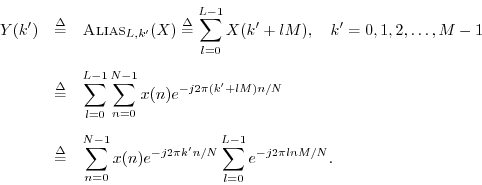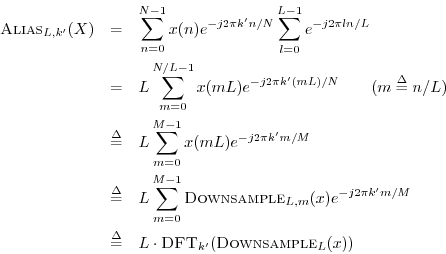Downsampling Theorem (Aliasing Theorem)
Theorem: For all
![]() ,
,

Proof: Let
![]() denote the frequency index in the
aliased spectrum, and
let
denote the frequency index in the
aliased spectrum, and
let
![]() . Then
. Then ![]() is length
is length ![]() ,
where
,
where ![]() is the downsampling factor. We have
is the downsampling factor. We have

Since ![]() , the sum over
, the sum over ![]() becomes
becomes
![$\displaystyle \sum_{l=0}^{L-1}\left[e^{-j2\pi n/L}\right]^l =
\frac{1-e^{-j2\p...
...ht) \\ [5pt]
0, & n\neq 0 \left(\mbox{mod}\;L\right) \\
\end{array} \right.
$](http://www.dsprelated.com/josimages_new/mdft/img1447.png)

Since the above derivation also works in reverse, the theorem is proved.
An illustration of aliasing in the frequency domain is shown in Fig.7.12.
Illustration of the Downsampling/Aliasing Theorem in Matlab
>> N=4; >> x = 1:N; >> X = fft(x); >> x2 = x(1:2:N); >> fft(x2) % FFT(Downsample(x,2)) ans = 4 -2 >> (X(1:N/2) + X(N/2 + 1:N))/2 % (1/2) Alias(X,2) ans = 4 -2
Next Section:
Zero Padding Theorem (Spectral Interpolation)
Previous Section:
Stretch Theorem (Repeat Theorem)




















